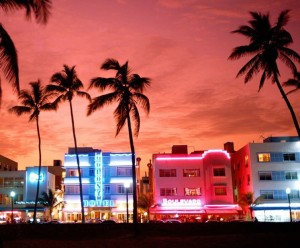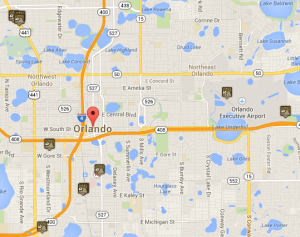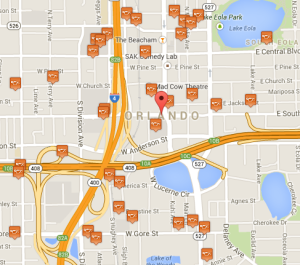If you’ve never been to Miami, Florida, you owe yourself at least one visit. Miami is a beautiful, vibrant metropolis that bridges the divide between north and South America both culturally and geographically. Miami is an economic heavy- weight with a bustling port, and thriving finance, commerce, media, entertainment and tourism trades. Miami is also the only major American city founded by a woman – Julia Tuttle, bought hundreds of acres back in 1875 believing that the area had the potential to become a trading hub between North and South America. She was right. Sure, Miami has its issues: a face eating pseudo-zombie, morally questionable politicians, and drivers with a death wish, but it’s still a great place to live. Here’s why:
weight with a bustling port, and thriving finance, commerce, media, entertainment and tourism trades. Miami is also the only major American city founded by a woman – Julia Tuttle, bought hundreds of acres back in 1875 believing that the area had the potential to become a trading hub between North and South America. She was right. Sure, Miami has its issues: a face eating pseudo-zombie, morally questionable politicians, and drivers with a death wish, but it’s still a great place to live. Here’s why:
1. The Climate – Miami, like much of Florida is subtropical. Being as far south as it is, the winters are extremely mild. While New York and Chicago were suffering through the ‘polar vortex’ last year, folks in Miami we’re enjoying 60-70 degree weather. That means they were walking around in T-shirts and shorts appreciating the scenic coconut palms through their stylish sunglasses. There’s no snow to shovel in Miami and being able to enjoy the beach in January is par for the course. Sure, the 90 degree summers and intense humidity can be a drag, but the sheer volume of bikini clad women is compensation enough for the summer heat.
2. The Beach – OK, this one is obvious. Miami’s beaches are world famous, but they’re famous for a reason. Crandon Park Beach is known as the party beach. A visit might include a model sighting or two and topless sunbathing is not only allowed but encouraged. Need we say more? If you’re looking for a more family friendly beach, you can head over to Matheson Hammock Park Beach, which is actually a man-made lagoon fed by the gentle tidal movements of Biscayne Bay. It’s calm and secluded – making it a nice spot to bring the kids. If you’re more into surfing, you can drop by Haulover Beach. It seems to get Miami’s biggest swells, but get there early to avoid the aggressive semi-pros who think they’re training for the professional circuit.
3. The Nightlife – Night clubs aren’t for everyone, but if you’re single and in your twenties or thirties, chances are you will like what Miami has to offer; Miami has some of the best night clubs in the world. There are tons of options, no matter what you’re into, but we’ll discuss a few of the more famous ones here. Mansion Nightclub is one Miami’s famous party spots. Often visited by models and hip hop celebs, the sound system is impeccable, the light shows are phenomenal and the guests are beautiful. The drinks are very expensive and you have to be well dressed to get through the door though. Mynt Lounge is a futuristic themed club frequented by actors, models and celebrities. It’s very exclusive and quite pricey. Finally, Nikki Beach is an open air club under the palm trees at the tip of Ocean Drive. It’s an upscale restaurant by day and transforms into a dance club and lounge at night. During the weekend nights, “anything goes”.
4. Fashion – If you’re into fashion, Miami is your spot in the southeast. There are three major fashion hubs in the US: Los Angeles, New York, and Miami…Miami doesn’t have apocalyptic traffic or nasty winters though. The city is home to worldwide modeling agencies such as Wilhelmina Models, Elite Model Management, and the William Morris Agency, along with renowned local agencies like The Green Agency. Miami has also been a home to designers such as Bruce Weber and Gianni Versace. If you’re more into shopping, Miami has a number of high fashion shopping destinations as well. The Webster Miami is a 20,000 square foot boutique that resides in an old art deco building in Miami’s South Beach area. It sells a variety of hard-to-find, exclusive brands. You can also visit the Miami Design District, which houses a number of high end boutiques in close proximity. Finally, Miami has three major fashion weeks: Mercedes-Benz Fashion Week Swim, Miami Beach International Fashion Week, and Funkshion Fashion Week.
5. Real Estate – While real estate prices may not be a great reason to move to a place on their own, they might give you the final push. The real estate market in south Florida, especially Miami, has been strong recently and will likely remain so. So if you’re looking for a tropical paradise with a good return on your property investment, Miami might be the place for you.
We hope this blog has turned you on to some of the great reasons to move to Miami. If you’re curious about specific neighborhoods in Miami, check out our MoveMap. It will tell you everything you need to know about a community before you ever set foot there!



